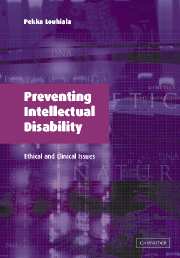Book contents
- Frontmatter
- Contents
- Acknowledgements
- 1 Introduction
- 2 On the definition of intellectual disability?
- 3 Epidemiology of intellectual disability
- 4 Prevention of intellectual disability: general issues
- 5 Prenatal diagnosis and screening
- 6 Genetic counselling
- 7 Why should intellectual disability be prevented?
- 8 Moral status and intellectual disability
- 9 The ethics of prevention in practice: three syndromes
- 10 Conclusion
- References
- Index
5 - Prenatal diagnosis and screening
Published online by Cambridge University Press: 09 August 2009
- Frontmatter
- Contents
- Acknowledgements
- 1 Introduction
- 2 On the definition of intellectual disability?
- 3 Epidemiology of intellectual disability
- 4 Prevention of intellectual disability: general issues
- 5 Prenatal diagnosis and screening
- 6 Genetic counselling
- 7 Why should intellectual disability be prevented?
- 8 Moral status and intellectual disability
- 9 The ethics of prevention in practice: three syndromes
- 10 Conclusion
- References
- Index
Summary
During the past four decades several techniques have been developed to enable physicians and geneticists to estimate the risk for certain diseases, syndromes and conditions or to set the exact diagnosis already during the foetal period. On the other hand, effective possibilities for curing or preventing these conditions have not been developed as rapidly. In fact, only foetal transfusions to manage, for example, serious blood group incompatibility can be considered routine treatment. Other forms of foetal therapy are still experimental.
One of the justifications for developing these new techniques has been that, in the future, it would be possible to treat conditions that we first learn to assess. One of the major rationalisations given to the human genome project has been that the characterisation of the human genome would lead to therapeutic innovations.
Prenatal investigations can be in the form of either screening or diagnostics. These terms are not used consistently, and they overlap, but in general the results of screening may be the demonstration of an increased risk for a certain condition (like Down syndrome or neural tube defect) or a definitive diagnosis. In a diagnostic procedure a definitive diagnosis is obtained or excluded, within the limits of uncertainty allowed by the chosen method. While, in the health care context in general, people come to ask for help, screening investigations are offered to people without any symptoms. An example of a test that can perform both a screening and a diagnostic function is ultrasonography.
- Type
- Chapter
- Information
- Preventing Intellectual DisabilityEthical and Clinical Issues, pp. 41 - 68Publisher: Cambridge University PressPrint publication year: 2003



